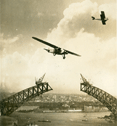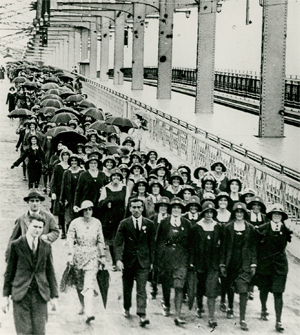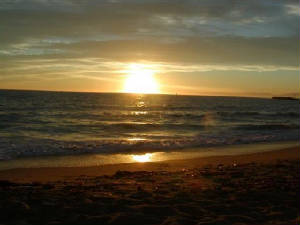 |
 |
 |
|
The Australia Page
|
 |
|

On March 18, 2007, the National Trust Centre at Observatory and Hill and surrounds will be transformed for the first
ever National Trust Day – there will be activities, entertainment and refreshments for the whole family. Details to
be advised; please check the website, enews and National Trust magazine for updates.
The day will coincide with mass celebrations for the 75th anniversary of the opening of the Sydney Harbour Bridge. The
bridge will be closed to vehicles, and it is expected that 250,000 will walk across it north to south – ending in the
National Trust grounds.
The Sydney Harbour Bridge’s
southern approach sits directly at the front of the National Trust Centre, Observatory Hill. At the time of the bridge’s
construction in the mid 1920s - 1932 the Trust Centre was Fort St School for Girls. Fort St School lost its Prices St entrance,
fountain and several buildings to the bridge approach construction.

The Sydney Harbour Bridge was entered on the National Trust’s Register in 1974, with the Classification
Report prepared by Jim Kerr and Meredith Walker. Reasons for Listing: -
“The bridge is one of the most remarkable feats of bridge construction. At the time of construction and until recently
it was the longest single span bridge in the world and is still in a general sense the largest. The bridge has been an important
factor in the pattern of growth of Metropolitan Sydney, particularly in residential development in post World War II years.
In the 60s and 70s the Central Business District had extended to the northern side of the bridge at North Sydney which has
been due in part to the easy access provided by the bridge and also to the increasing traffic problems associated with the
Bridge. The bridge, its pylons and its approaches are all important elements in townscape of areas both near and distant from
it. The curved northern approach gives a grand sweeping entrance to the bridge with continually changing views of the bridge
and harbour.”
The Trust, in recent years, has commented on proposals for adaptations to the bridge. The Trust did not object to these
proposals
|
 |
|
|
 |
|
|
 |
|
|
 |
|
|
 |
 |
 |
|
Enter supporting content here
|

|
|
InterCultural Communications Programs:
International International Communications: There a several aspects in shared human experiences, and the aspiration they contain which bond a people to a culture
and behavior. The ongoing process of development contained within this website sequencing of websites are to give bench
marks of what is entailed in various culture's and nation's experience.
InterCultrual Communications: There is a process in how to examine then promote basic features of the full cultural experience. This website
is an interactive education - orientation process which likewise enlist additonal information by each participant of there
own efforts of personal discoveries; thus will add them according to the value of the information being provided.
Cross Webbing:
The combination of these speicalized webing arrangement of sites are to give focus, and a training manual
text in developing Intercultural Communications Internet Network, and the basis of its development, Cultural Democracy.
This adds a unique supportive feature in the additional developement of the Inter - Cities Cultural Communications Program
initiated by Mr. Roger M. Christian.
***
International InterCultural Communications and International Students / Scholars role finctions. Here within this WebSite footer you will see several links which are connected to the major website
with InterCultural Communications are it subject matter, as well as in its promotions within the Internet. This has
now proved to most effective, as you are now see thins as a result of earned google dot com rankings.
Campus Network ~ International and National Cultural Fiesta Movement :
|
|
|
